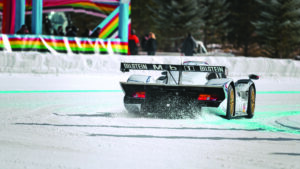Ice Race Aspen
HOME » Magazine » April 2024 » Features and Reports » Ice Race Aspen
The ICE Concours in St Moritz may have been cancelled due to bad weather, but meanwhile on the other side of the Atlantic, the Ice Race Aspen had a special star attraction when Stéphane Ortelli drove the very same Porsche 911 GT1 in which he won the 1998 24 Hours of Le Mans on the snowy track.
Across a three-day weekend of modern and historic races and demonstration drives, the Porsche 911 GT1 was undoubtedly the star attraction of Ice Race Aspen. This was the brainchild of Ferdinand Porsche, Ferry Porsche’s grandson, who five years ago revived the historic event that was held on the frozen Lake Zell in Austria until 1974. Drawing Porsche enthusiasts from around the world to the tiny town of Zell Am See, home to the Porsche family for generations, the reborn Ice Race quickly became immensely popular. So much so that the decision was taken to go further afield in 2024, to Aspen, with its own tradition of street racing.

In 1951, the first of five annual street races was run in front of Aspen’s famous Hotel Jerome, with a field of cars weaving through its unpaved streets. By the end of 1955, racing on public roads in Colorado had been outlawed, putting an end to the fun. Almost 70 years later, the F.A.T Ice Race Aspen saw an eclectic collection of racing cars being put through their paces at the Tree Farm in Carbondale, a few kilometres north of the town.
In order to allow a car weighing just over 1000 kg, and with a heavily boosted 550hp at the rear wheels, to drive in such unlikely conditions, the Porsche Museum’s engineers fitted special winter tyres, at the same time raising the suspension to allow room for the new rubber inside the GT1-98’s wheel arches. An additional pre-heating system from the 919 Hybrid was also installed.

Ortelli points out that despite the incongruous sight of the 911 GT1 on snow, Porsche’s early sports cars were designed for, and developed in the mountains, and designed to handle well. But surely the GT1 was designed to have ultra-high levels of grip and downforce for the top speeds down the Mulsanne Straight?
“You have to forget about all that,” Ortelli laughed. “Here, it’s more like ballet. The tyres grip well on the compact snow, and you can immediately feel the car’s potential and follow the racing line, but you have to use the weight transfer to turn. Partly because the car is so stiff, but also because the steering rack is so quick. We all know that when you go sideways you need to steer to compensate for the angle of the car, but in the GT1 you have so little lock. For me that has been the most challenging thing to adapt to. You find full lock so fast that you need to play with the gas and left foot brake to limit the slide. It was a lot of work on the wheel and the pedals. But it really was like a ballet, and on the snow, this car can really dance! This is what’s great about the Porsche Museum. They not only prepare the cars for shows, but make sure we can drive them, and drive them fast. Even Le Mans winners on snow. I will remember this experience for the rest of my life!”

Photos Courtesy Porsche
These stories are all from the pages of Historic Motor Racing News. Some have been abbreviated for this web site. If you'd like to receive the full version, please visit our subscription page where you will find postal subscriptions available. A full subscription also entitles you to access the current issue online (available soon), so you can take it with you and read it anywhere, and we are working on providing full access to our archives of back issues exclusively for our subscribers.